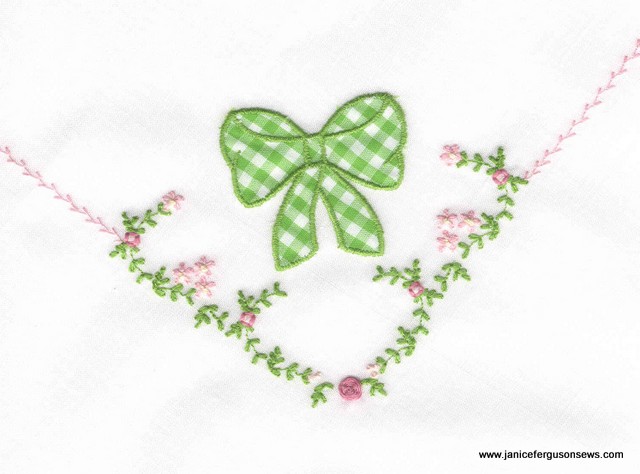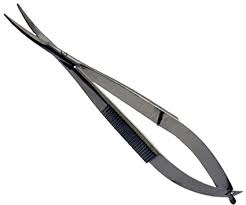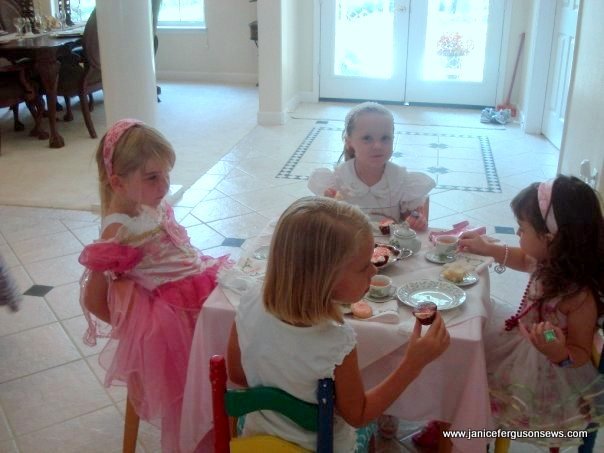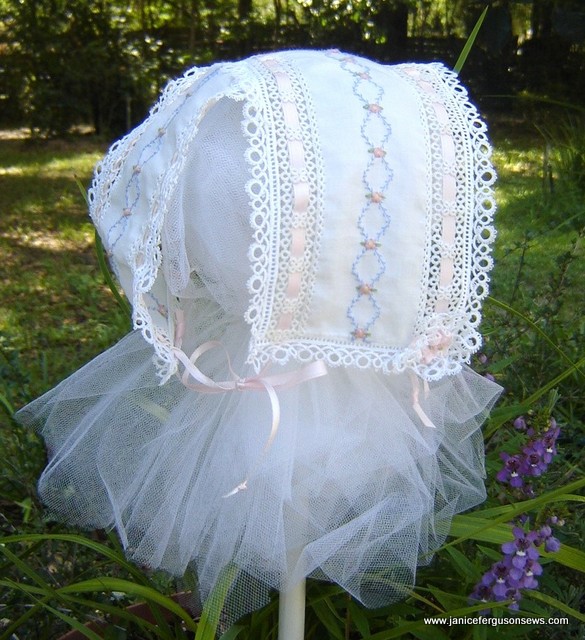
Tea table is set up in front of a mural Suzanne Sawko painted in her grandchildren’s playroom at her house.
Several years ago, I made this tea set table cloth and napkins for my Nana’s hope chest. At that time, having a tea party with grandchildren seemed like a dream that would bring immeasurable joy. And now this dream has come true.

Laurel at one of her first tea parties
Robert and Laurel have been taught that at social occasions, they are not to talk about their health, religion or politics. One of Laurel’s first questions was, “What’s politics?” I told her to never mind for now, but to remember this rule for when she did know. “Then what do we talk about?” she asked. “I told her that we ask about one anothers mothers, gardening and our sewing. Now, at the first sip of “tea,”she asks how my roses are.
This initial inspiration for the project was finding a lovely little child size porcelain tea set. The style is suggestive of Mary Engelbreit, but really is just a generic design and seemed to be easy enough to replicate. Wouldn’t it be fun, I thought, to copy this sweet design onto a child sized tea cloth and napkins!
When computerized machine embroidery was brand new to the sewing world, Pfaff ran an advertisement showing how they had copied a china pattern onto a tablecloth. I could do that! Well, maybe with a little help, I could.

Mary Alice Smith of Alabama kindly digitized the applique bow for me and I took the flowers from one of the machine embroidery collections that Suzanne Sawko and I did.

Some of my favorite sewing techniques are incorporated into this project: machine embroidery, hemstitching, feather stitching, monogramming and applique. As a big fan of heirloom sewing, I used 100% linen. But the charm of a tea party with grandchildren would not be diminished by the use of a polycotton blend. Use what you have or what you like.
SEWING HOW TO
SUPPLIES:
- fabric: linen: 30″ square for tablecloth, gingham: 12″ square for 5 bow appliques
- machine embroidery bow applique: digitized by Mary Alice Smith
- NOTE:Â If you would like this design, post your request as a comment in the section below. I will e-mail it to you in .pes format.
- floral designs: Fil Tire’ and Fancywork Combinations
- monogram: Brother PE-Design font #22
- threads: for hemstitching –80 wt. Madeira Cotona or 60 wt. Mettler or 50 wt. DMC
- for embroidery–green, pink, lt. pink, yellow
- corner template: from white cardboard or Templar, cut template 5″ square. Cut one corner round.

- needles: wing or 100 universal for hemstitching, 80 for embroidery
TABLECLOTH PREPARATION:
- PIN STITCH EDGE (point de Paris) or other finish such as feather stitch or roll and whip
- 1. Fold 1/4″ along each edge and press.
- 2. Round each corner. Spray starch and then fold each corner over corner template.
- 3. For pin stitch or decorative edge, use pink Madeira Cotona 80 wt. cotton thread in needle and bobbin.
- 4. Insert wing or #100 universal needle for pin stitch.
- 5. Set pin stitch to W. 3.0 and L. 3.0 or as desired and engage needle down function, if available.
Work on practice piece first to see how to line up fabric. Then stitch around cloth edge with pin stitch, making certain that the the right swing of the needle is going off the folded edge. As rounded corners are approached, execute pivot after the needle finishes reach to right, off the edge of fabric, and has returned to the previous “hole” in the fabric.
NOTE: When you approach the origin of the pin stitching, try to line up by adjusting the length of the stitch, so that you complete the stitching by piercing the first hole with a repeat stitch.
4. Cut away excess fabric VERY carefully with curved embroidery snips or blunt nose “kindergarten” scissors.

NAPKINS
- 1. Spray starch and press all 4 napkins.
- 2. Press 1/4″ from each raw edge.
- 3. Round corners, pin stitch and trim as on tablecloth.
TABLECLOTH EMBROIDERY MOTIFS
- 1. Press diagonal crease or mark diagonal line with washaway marker on two diagonally opposite corners.
- 2. Using hoop embroidery or other applique’ technique, apply bow and floral corner design, with bow centered on the diagonal crease.
- 3. On diagonally opposite corner, embroider monogram and floral frame, with monogram centered on the diagonal crease.

NAPKIN EMBROIDERY
Hoop embroidery:
- 1. On one corner of each napkin, press diagonal crease or mark diagonal line with washaway marker, as on tablecloth.
- 2. Using hoop embroidery or machine embroidery, stitch floral frame and monogram.
TABLECLOTH FEATHERSTITCH FRAMEWORK
- 1. With pink 50 wt. cotton thread, work feather stitch along 6 ” crease line around tablecloth.  Start and stop at corner floral design.
- 2. Wash out blue marks, starch and press.
- 3. Invite a grandchild or young friend for tea.
kindergarten tea recipe:
- 2/3 cup instant tea 2 small envelopes lemonade mix
- 1 lb. jar Tang 2 teaspoons cinnamon
- 2 cups sugar 2 teaspoons ground cloves
- Mix well.
- Add 2-3 teaspoons to 1 cup hot water.
Laurel’s mother thought it would be fun for Laurel to host a tea party for her friends. She and Laurel made cookies and little sandwiches. Her mother Shelly even provided gloves for the little guests’ dress up fun. Meanwhile, Laurel learned a little about hostessing.


Laurel hosting tea party for friends.

After rummaging through the dress up box, they were ready for tea.













